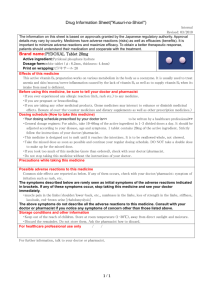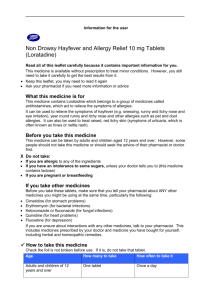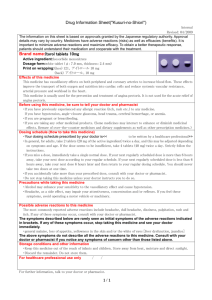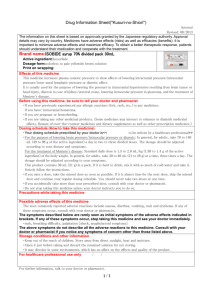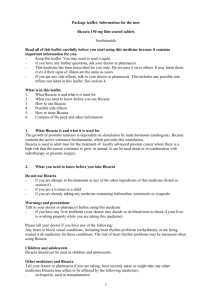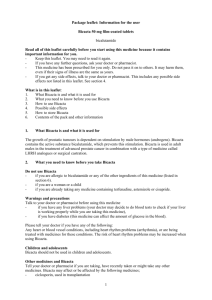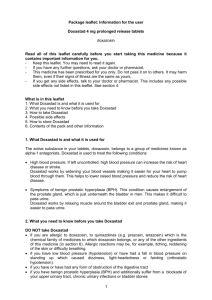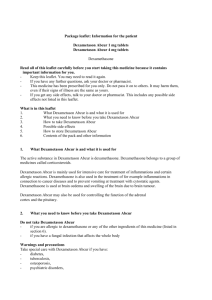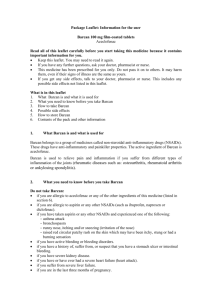Drug Information Sheet("Kusuri-no-Shiori") Internal Revised: 09
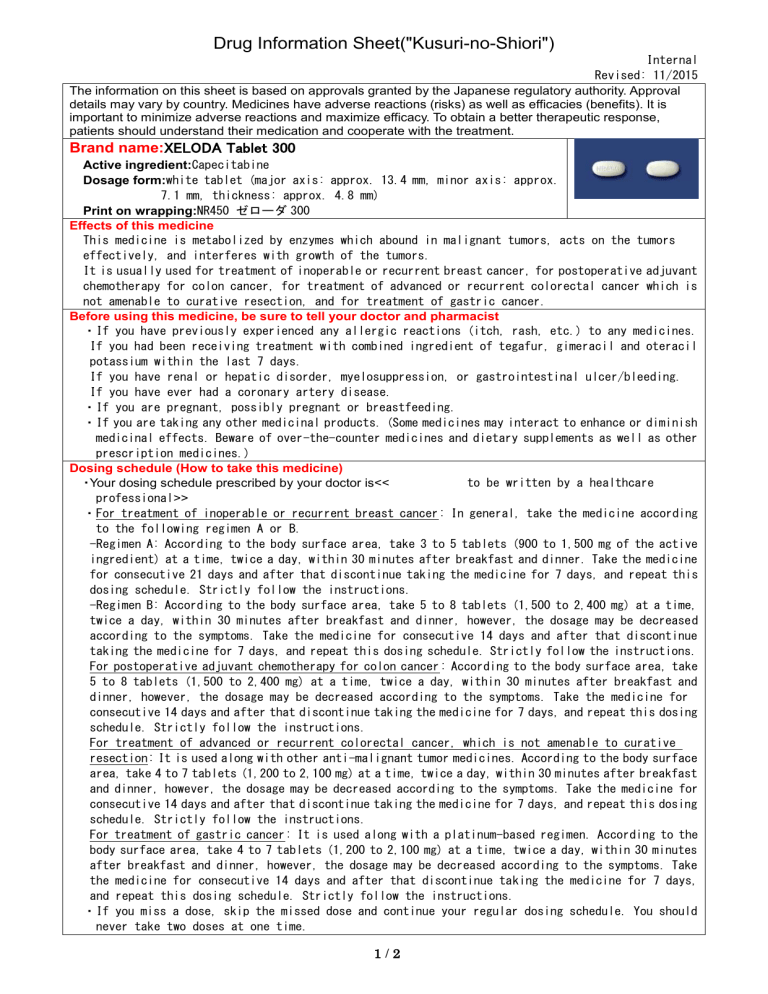
Drug Information Sheet("Kusuri-no-Shiori")
Internal
Revised: 11/2015
The information on this sheet is based on approvals granted by the Japanese regulatory authority. Approval details may vary by country. Medicines have adverse reactions (risks) as well as efficacies (benefits). It is important to minimize adverse reactions and maximize efficacy. To obtain a better therapeutic response, patients should understand their medication and cooperate with the treatment.
Brand name: XELODA Tablet 300
Active ingredient: Capecitabine
Dosage form: white tablet (major axis: approx. 13.4 mm, minor axis: approx.
7.1 mm, thickness: approx. 4.8 mm)
Print on wrapping: NR450 ゼローダ 300
Effects of this medicine
This medicine is metabolized by enzymes which abound in malignant tumors, acts on the tumors effectively, and interferes with growth of the tumors.
It is usually used for treatment of inoperable or recurrent breast cancer, for postoperative adjuvant chemotherapy for colon cancer, for treatment of advanced or recurrent colorectal cancer which is not amenable to curative resection, and for treatment of gastric cancer.
Before using this medicine, be sure to tell your doctor and pharmacist
・If you have previously experienced any allergic reactions (itch, rash, etc.) to any medicines.
If you had been receiving treatment with combined ingredient of tegafur, gimeracil and oteracil potassium within the last 7 days.
If you have renal or hepatic disorder, myelosuppression, or gastrointestinal ulcer/bleeding.
If you have ever had a coronary artery disease.
・If you are pregnant, possibly pregnant or breastfeeding.
・If you are taking any other medicinal products. (Some medicines may interact to enhance or diminish medicinal effects. Beware of over-the-counter medicines and dietary supplements as well as other prescription medicines.)
Dosing schedule (How to take this medicine)
・ Your dosing schedule prescribed by your doctor is<< to be written by a healthcare professional >>
・For treatment of inoperable or recurrent breast cancer: In general, take the medicine according to the following regimen A or B.
-Regimen A: According to the body surface area, take 3 to 5 tablets (900 to 1,500 mg of the active ingredient) at a time, twice a day, within 30 minutes after breakfast and dinner. Take the medicine for consecutive 21 days and after that discontinue taking the medicine for 7 days, and repeat this dosing schedule. Strictly follow the instructions.
-Regimen B: According to the body surface area, take 5 to 8 tablets (1,500 to 2,400 mg) at a time, twice a day, within 30 minutes after breakfast and dinner, however, the dosage may be decreased according to the symptoms. Take the medicine for consecutive 14 days and after that discontinue taking the medicine for 7 days, and repeat this dosing schedule. Strictly follow the instructions.
For postoperative adjuvant chemotherapy for colon cancer: According to the body surface area, take
5 to 8 tablets (1,500 to 2,400 mg) at a time, twice a day, within 30 minutes after breakfast and dinner, however, the dosage may be decreased according to the symptoms. Take the medicine for consecutive 14 days and after that discontinue taking the medicine for 7 days, and repeat this dosing schedule. Strictly follow the instructions.
For treatment of advanced or recurrent colorectal cancer, which is not amenable to curative resection: It is used along with other anti-malignant tumor medicines. According to the body surface area, take 4 to 7 tablets (1,200 to 2,100 mg) at a time, twice a day, within 30 minutes after breakfast and dinner, however, the dosage may be decreased according to the symptoms. Take the medicine for consecutive 14 days and after that discontinue taking the medicine for 7 days, and repeat this dosing schedule. Strictly follow the instructions.
For treatment of gastric cancer: It is used along with a platinum-based regimen. According to the body surface area, take 4 to 7 tablets (1,200 to 2,100 mg) at a time, twice a day, within 30 minutes after breakfast and dinner, however, the dosage may be decreased according to the symptoms. Take the medicine for consecutive 14 days and after that discontinue taking the medicine for 7 days, and repeat this dosing schedule. Strictly follow the instructions.
・If you miss a dose, skip the missed dose and continue your regular dosing schedule. You should never take two doses at one time.
1 / 2
・If you accidentally take more than your prescribed dose, consult with your doctor or pharmacist.
The medicine may cause serious nausea, vomiting, diarrhea, mucositis, gastrointestinal stimulus or bleeding, or myelosuppression.
・Do not stop taking this medicine unless your doctor instructs you to do so.
Precautions while taking this medicine
・The medicine may decrease the immune system, and is likely to cause infections such as cold. Take enough care, such as to avoid being in crowd, to wash the hands and to gargle after returning home.
・Avoid breastfeeding.
Possible adverse reactions to this medicine
The most commonly reported adverse reactions include hand-foot syndrome, nausea/vomiting, loss of appetite, diarrhea, stomatitis, neurotoxicity (peripheral sensory neuropathy, peripheral motor neuropathy etc), fatigue and injection site reaction. If any of these symptoms occur, consult with your doctor or pharmacist.
The symptoms described below are rarely seen as initial symptoms of the adverse reactions indicated in brackets. If any of these symptoms occur, stop taking this medicine and see your doctor immediately.
・general malaise, thirst, hyperventilation, shaky hands and fingers, decreased urinary volume, faint consciousness, impaired mind/judgment [dehydration]
・sensitivity or insensitivity, redness and swelling, pain, skin strip, blister, skin sore on the palms of the hands and/or the soles of the feet [hand-foot syndrome]
・general malaise, swollen body, cold sweat, dizziness, easy breathing in upright position, breathing difficulty, shortness of breath, palpitation, palpitation when moving, chest pain, anginal pain, chest constriction/pressured feeling, strong chest oppressive feeling, sense of being compressed strongly on the chest drastically, faint [cardiac disorder]
・general malaise, yellowness in the skin and/or the white of the eyes, itch, dark or brown urine, loss of appetite, nausea, vomiting [hepatic disorder, jaundice]
・headache, swollen face/eyelids, decreased urinary volume [renal disorder]
・general malaise, fever, gum/nose bleeding, shortness of breath, blue spot, prolonged bleeding, bleeding tendency [myelosuppression]
・mucosa irritation in the mouth [stomatitis]
・dry cough, breathlessness, shortness of breath, fever [interstitial pneumonia]
・severe abdominal pain, diarrhea, bloody stool, fever, feeling sick at the stomach, nausea, vomiting, enlarged feeling of abdomen [serious enteritis (hemorrhagic/ischemic/necrotizing enteritis, etc.)]
・memory loss, lightheadedness, absent-mindedness, difficulty memorizing, difficulty speaking, loss of consciousness, convulsion [serious psychoneurotic disorder (leukoencephalopathy, etc.)]
・paralysis/numbness of the limbs, difficulty speaking, chest pain, breathing difficulty, sudden pain/swelling in one leg, back pain [thrombosis]
・general malaise, loss of appetite, fever, high fever, red patch with dropsical swelling in the center, red rash, inflamed eye and eyelid, conjunctival sore, severe stomatitis, lip/intraoral sore, pain in the genitalia [mucocutaneous ocular syndrome (Stevens-Johnson syndrome)]
The above symptoms do not describe all the adverse reactions to this medicine. Consult with your doctor or pharmacist if you notice any symptoms of concern other than those listed above.
Storage conditions and other information
・Keep out of the reach of children. Store at room temperature (1 to 30℃), away from direct sunlight and moisture.
・Discard the remainder. Do not store them. Ask the pharmacist or healthcare facility how to discard them.
For healthcare professional use only / /
For further information, talk to your doctor or pharmacist.
2 / 2
